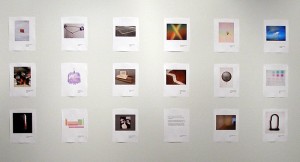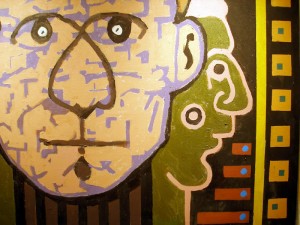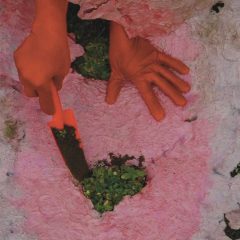Much of the work around the Kensington area this month questions the divide between technology and artist. First up is the Brad Troemel Pre-career Retrospective at Extra Extra Gallery. The gallery directors curated the show entirely from Troemel’s website selecting images of work, installations, and videos and installing the show without consulting the artist in the process. On the Extra Extra website they explain: “This gesture of presenting work without the consent of the creator is emblematic of immaterial art’s free movement into any receptive home.”


The selected works were printed out on plain copy paper with no worries about archival materials—the prints are not meant to last. The works themselves seem to be a tribute to ephemera—documentation of the meaningless, or accidental, or silly. A photo of a tree branch rolled up in a car window is listed as an installation as though any action in life could be a performance and every object, a sculpture. A potato held to a wall with band-aids, a sandwich on a bedpost, a piñata on fire; the images are all roughly the same size and are distributed around three walls of the gallery in a grid with none given precedence and in no particular order. All of life aggregated through technology into an endless series of unnoticed art blobs. The show is captivating and witty, getting funnier the longer you look.

The paintings in George Shinn’s New, Renew & Rerun show at Highwire Gallery took the reverse path. While Troemel starts in reality and moves to the digital; Shinn starts with a digital process in order to create something almost primitive. Shinn draws using Mac Paint and then transfers the designs to canvas and paints the images the old-fashioned way. The resulting pictures of faces and groups have a blocky style that echoes Northwest Coast Native American design. Heavy shadows and outlines on the faces stand out against empty backgrounds with decorative patterning—the faces become reminiscent of cartoons or primitive masks with the pixilation of digital design still visible in some of the figures.

At InLiquid Art + Design Chad Curtis’ Drawing Machine continues the dialogue between technology and art. It is a computer-driven mechanical armature that draws pictures reminiscent of some ornithological paint-by-numbers series. The nature scenes and Audubon-style illustrations of birds appear with perfect regularity as the pen glides on its pre-planned flight path. But the products seem a little soulless, waiting for the weekend painter to come and fill it in with color.

The Ice Box’s large group show of print works: Medium Resistance promises a continuation of this inquiry into the possibilities inherent in developing media: “these works reassess the mediums’ expressive, communicative, and material possibilities … strategically exploring each format’s relative autonomy and usefulness, its potential for participation and collaboration, communication and dissemination, aesthetic, social, and technical labor.” But this broad and confusing introduction leads in to a show that is relatively conventional.
While the work is solid, the format is very traditional with many 2-D prints hugging the walls and rarely venturing out into the center of the room. The standout exception is Andree-Anne Dupuis-Bourret’s La Debacle a landscape that spreads across the floor like a mini-mountain range of perfectly regular hills. Standing above the tiny peaks—softly shaded from mostly white to nearly black—it is easy to have a sense of vertigo as if entering upon a science fiction landscape sprung up from the pages of a hand-printed volume.

Other enjoyable pieces include Piper Shepard’s Pattern Pinning an 8’ x 8’ installation of corsage pins and printed floral borders that blend visually into a virtual quilt.

Colette Fu’s oversize photography pop-up books are captivating with their odd blend of subject, content and juvenile format. Over all there are many strong pieces and interesting installations, but the show lacks coherence, possibly as a result of its somewhat overwrought mission. Despite the claim to question material possibilities and the new potential for communication the show is particularly lacking in work that addresses the effects of new technologies or crosses any as yet untraversed boundaries.
More about this post’s author, S. Tiernan Alexander









